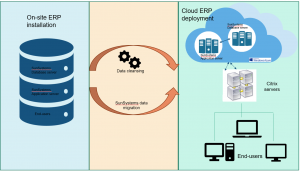For the most recent project we delivered, we had to migrate SunSystems v4.3.3 from an on-premise installation to Microsoft Azure Cloud. Being our first project of this kind, we had to try first, to make sure we can deliver what we were about to promise. We installed SUN in our Cloud environment and run it without problems. So, it can be done!
When the time came, we started the installation in the client’s Cloud environment. It was a multitier installation and, in the first phase of the project, the two machines, the Database server and the Application server, were not in the same domain, just separate machines with Public network. It was a real challenge to establish connection between them. Even though the necessary ports seemed to be open we could not get communication between the 2 servers. Special rules had to be created in the Firewall and in Windows permissions.
But the surprises were yet to come: when the servers were moved in a domain, all connections were lost (and this was done during the weekend before User Validation 1). We had to rename and recreate some users and user groups, late night discussions and brainstorming finally solved the problem and the system was ready for the User Validation 1.
To sum up important learnings of the project, we would say that:
• Try to replicate the environment in your own infrastructure before deploying. Make sure you test all the features and functionalities
• Have an ongoing communication with customer’s IT/infrastructure team to make sure that both parties understand the naming conventions, access permissions, IP addresses,
priorities and firewall rules before deploying
• When installing SunSystems v4.3.3 in Cloud, make sure that you have the final environment configuration, meaning the set up as it should be after Go-Live, to avoid double work
• While on-site test the access with every single user before any validation • Prepare a list of all User Groups, Users and permissions that will be needed for setting up the system and make sure you obtain those permissions in timely manner
• Double check and triple confirm with the users what are the connected applications that will be needed in their daily operations
• MS Access tools could become challenging, as the application itself seems not to be able to keep up with the evolution of the technology and Cloud environment
• Same as in all project, make sure that all users have the knowledge, the means and the time to proper test all the systems they will work with in their day-to-day activities after the
migration
All-in-all the project was delivered in time and on budget due to the dedication of the teams involved, great communication and response time both from the users and the support teams (IT, consultants, 3rd party application developers and ERP producer).
Copyright FSSGlobal 2018. All rights reserved. More details on www.fssglobal.com
